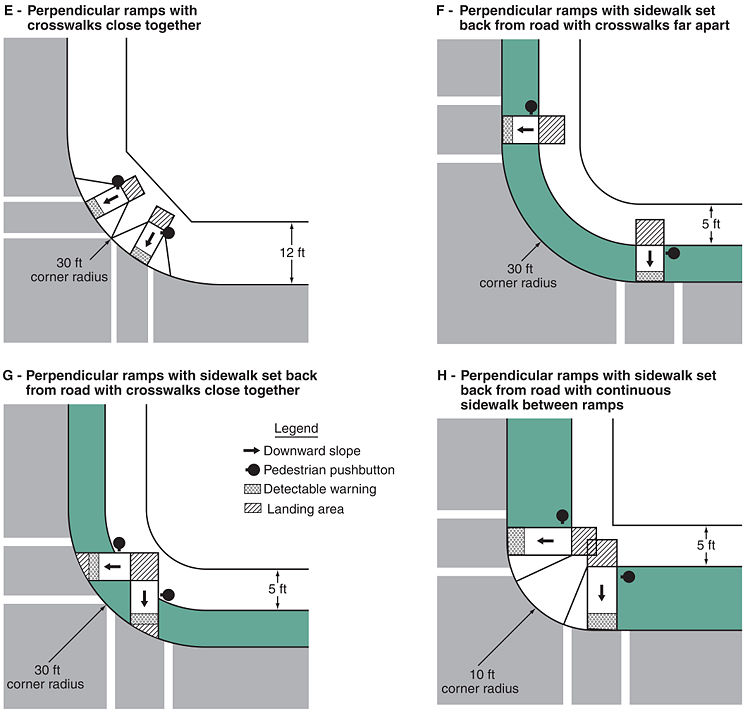902.6 Pedestrian Control Features (MUTCD Chapter 4E): Difference between revisions
m updated links |
m updated links |
||
| Line 142: | Line 142: | ||
'''Option.''' On a street with a median of sufficient width for pedestrians to wait, a pedestrian clearance time that allows the pedestrian to cross only from the curb or shoulder to the median may be provided. | '''Option.''' On a street with a median of sufficient width for pedestrians to wait, a pedestrian clearance time that allows the pedestrian to cross only from the curb or shoulder to the median may be provided. | ||
'''Standard.''' Where the pedestrian clearance time is sufficient only for crossing from the curb or shoulder to a median of sufficient width for pedestrians to wait, median-mounted pedestrian signals (with pedestrian detectors if actuated operation is used) shall be provided (see EPG 902.6.7 and EPG 902.6.8) and signing such as the R10-3d sign (see [[903.5 Regulatory Signs#903.5.30 Traffic Signal Signs (R10-3, R10-5 through R10-30) (MUTCD | '''Standard.''' Where the pedestrian clearance time is sufficient only for crossing from the curb or shoulder to a median of sufficient width for pedestrians to wait, median-mounted pedestrian signals (with pedestrian detectors if actuated operation is used) shall be provided (see EPG 902.6.7 and EPG 902.6.8) and signing such as the R10-3d sign (see [[903.5 Regulatory Signs#903.5.30 Traffic Signal Signs (R10-3, R10-5 through R10-30) (MUTCD Sections 2B.53 and 2B.54)|EPG 903.5.30]]) shall be provided to notify pedestrians to cross only to the median to await the next WALKING PERSON (symbolizing WALK) signal indication. | ||
'''Guidance.''' Where median-mounted pedestrian signals and detectors are provided, the use of accessible pedestrian signals (see [[#902.6.9 Accessible Pedestrian Signals and Detectors – General (MUTCD Section 4E.13)|EPG 902.6.9]]) should be considered. | '''Guidance.''' Where median-mounted pedestrian signals and detectors are provided, the use of accessible pedestrian signals (see [[#902.6.9 Accessible Pedestrian Signals and Detectors – General (MUTCD Section 4E.13)|EPG 902.6.9]]) should be considered. | ||
Revision as of 10:14, 18 December 2012
902.6.1 Pedestrian Signal Heads (MUTCD Section 4E.01)
Support. Pedestrian signal heads provide special types of traffic signal indications exclusively intended for controlling pedestrian traffic. These signal indications consist of the illuminated symbols of a WALKING PERSON (symbolizing WALK) and an UPRAISED HAND (symbolizing DONT WALK).
Guidance. Engineering judgment should determine the need for separate pedestrian signal heads (see EPG 902.5.9) and accessible pedestrian signals (see EPG 902.6.9). All pedestrian indication displays at any intersection should be consistent.
Support. EPG 902.7 contains information regarding the use of pedestrian hybrid beacons and EPG 902.14 contains information about using In-Roadway Warning Lights at unsignalized marked crosswalks.
902.6.2 Meaning of Pedestrian Signal Head Indications (MUTCD Section 4E.02)
Standard. Pedestrian signal head indications shall have the following meanings:
A. A steady WALKING PERSON (symbolizing WALK) signal indication means that a pedestrian facing the signal indication is permitted to start to cross the roadway in the direction of the signal indication, possibly in conflict with turning vehicles. The pedestrian shall yield the right-of-way to vehicles lawfully within the intersection at the time that the WALKING PERSON (symbolizing WALK) signal indication is first shown.
B. A flashing UPRAISED HAND (symbolizing DONT WALK) signal indication means that a pedestrian shall not start to cross the roadway in the direction of the signal indication, but that any pedestrian who has already started to cross on a steady WALKING PERSON (symbolizing WALK) signal indication shall proceed to the far side of the traveled way of the street or highway, unless otherwise directed by a traffic control device to proceed only to the median of a divided highway or only to some other island or pedestrian refuge area.
C. A steady UPRAISED HAND (symbolizing DONT WALK) signal indication means that a pedestrian shall not enter the roadway in the direction of the signal indication.
D. A flashing WALKING PERSON (symbolizing WALK) signal indication has no meaning and shall not be used.
902.6.3 Application of Pedestrian Signal Heads (MUTCD Section 4E.03)
Before pedestrian indications are considered for a location refer to EPG 902.5.9 through EPG 902.5.13 and EPG 642 Pedestrian Facilities for information regarding ADA accessibility requirements.
Standard. Pedestrian signal heads shall be used in conjunction with vehicular traffic control signals under any of the following conditions:
A. If a traffic control signal is justified by an engineering study and meets either Warrant 4, Pedestrian Volume or Warrant 5, School Crossing (see EPG 902.3);
B. If an exclusive signal phase is provided or made available for pedestrian movements in one or more directions, with all conflicting vehicular movements being stopped;
C. At an established school crossing at any signalized location; or
D. Where engineering judgment determines that multi-phase signal indications (as with split-phase timing) would tend to confuse or cause conflicts with pedestrians using a crosswalk guided only by vehicular signal indications.
Guidance. Pedestrian signal heads should be used under any of the following conditions:
A. If it is necessary to assist pedestrians in deciding when to begin crossing the roadway in the chosen direction or if engineering judgment determines that pedestrian signal heads are justified to minimize vehicle-pedestrian conflicts;
B. If pedestrians are permitted to cross a portion of a street, such as to or from a median of sufficient width for pedestrians to wait, during a particular interval but are not permitted to cross the remainder of the street during any part of the same interval; and/or
C. If no vehicular signal indications are visible to pedestrians, or if the vehicular signal indications that are visible to pedestrians starting a crossing provide insufficient guidance for them to decide when to begin crossing the roadway in the chosen direction, such as on one-way streets, at T-intersections, or at multi-phase signal operations.
Option. Pedestrian signal heads may be used under other conditions based on engineering judgment.
902.6.4 Size, Design, and Illumination of Pedestrian Signal Head Indications (MUTCD Section 4E.04)
Standard. All new pedestrian signal head indications shall be displayed within a rectangular background and shall consist of symbolized messages (see Fig. 902.6.4), except that existing pedestrian signal head indications with lettered or outline style symbol messages shall be permitted to be retained for the remainder of their useful service life. The symbol designs that are set forth in the “Standard Highway Signs and Markings” book (see EPG 900.1.11 Relation to Other Publications) shall be used. Each pedestrian signal head indication shall be independently displayed and emit a single color.
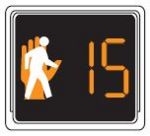
If a two-section pedestrian signal head is used, the UPRAISED HAND (symbolizing DONT WALK) signal section shall be mounted directly above the WALKING PERSON (symbolizing WALK) signal section. If a one-section pedestrian signal head is used, the symbols shall be either overlaid upon each other or arranged side-by-side with the UPRAISED HAND symbol to the left of the WALKING PERSON symbol, and a light source that can display each symbol independently shall be used.
The WALKING PERSON (symbolizing WALK) signal indication shall be white, conforming to the publication entitled “Pedestrian Traffic Control Signal Indications” (see EPG 900.1.11 Relation to Other Publications), with all except the symbol obscured by an opaque material.
The UPRAISED HAND (symbolizing DONT WALK) signal indication shall be Portland orange, conforming to the publication entitled “Pedestrian Traffic Control Signal Indications” (see EPG 900.1.11 Relation to Other Publications), with all except the symbol obscured by an opaque material.
When not illuminated, the WALKING PERSON (symbolizing WALK) and UPRAISED HAND (symbolizing DONT WALK) symbols shall not be readily visible to pedestrians at the far end of the crosswalk that the pedestrian signal head indications control.
For pedestrian signal head indications, the symbols shall be at least 9 in. tall.
The light source of a flashing UPRAISED HAND (symbolizing DONT WALK) signal indication shall be flashed continuously at a rate of not less than 50 or more than 60 times per minute. The displayed period of each flash shall be a minimum of 1/2 and a maximum of 2/3 of the total flash cycle.
Guidance. Pedestrian signal head indications should be conspicuous and recognizable to pedestrians at all distances from the beginning of the controlled crosswalk to a point 10 ft. from the end of the controlled crosswalk during both day and night.
If the pedestrian signal indication is so bright that it causes excessive glare in nighttime conditions, some form of automatic dimming should be used to reduce the brilliance of the signal indication.
902.6.5 Location and Height of Pedestrian Signal Heads (MUTCD Section 4E.05)
Standard. Pedestrian signal heads shall be mounted with the bottom of the signal housing including brackets not less than 7 ft. or more than 10 ft. above sidewalk level, and shall be positioned and adjusted to provide maximum visibility at the beginning of the controlled crosswalk.
If pedestrian signal heads are mounted on the same support as vehicular signal heads, there shall be a physical separation between them.
902.6.6 Pedestrian Intervals and Signal Phases (MUTCD Section 4E.06)
Support. At times, it can be difficult to time for pedestrians. On one side is the duty to consider the time needed to allow pedestrians of all travel speeds to cross wide roadways. On the other side is the responsibility to operate busy arterials to their peak capacity by minimizing stops and delay for the vehicles. These two goals are usually in conflict if every green interval must be timed long enough to accommodate pedestrians.
The walk interval is intended for pedestrians to start their crossing. The pedestrian clearance time is intended to allow pedestrians who started crossing during the walk interval to complete their crossing. Confusion is common among pedestrians as to the meaning of the indications. This can result in a pedestrian turning back once the WALK time expires and not using the flashing DON'T WALK to cross. Every effort is to be made to educate the public to the meanings of these indications instead of lengthening the WALK time, since the flashing DON'T WALK time is the critical time. Countdown pedestrian indications can help confusion issues see EPG 902.6.7 Countdown Pedestrian Signals.
Standard. At intersections equipped with pedestrian signal heads, the pedestrian signal indications shall be displayed except when the vehicular traffic control signal is being operated in the flashing mode. At those times, the pedestrian signal indications shall not be displayed.
When the pedestrian signal heads associated with a crosswalk are displaying either a steady WALKING PERSON (symbolizing WALK) or a flashing UPRAISED HAND (symbolizing DONT WALK) signal indication, a steady red signal indication shall be shown to any conflicting vehicular movement that is approaching the intersection or midblock location perpendicular or nearly perpendicular to the crosswalk.
When pedestrian signal heads are used, a WALKING PERSON (symbolizing WALK) signal indication shall be displayed only when pedestrians are permitted to leave the curb or shoulder.
A pedestrian change interval consisting of a flashing UPRAISED HAND (symbolizing DONT WALK) signal indication shall begin immediately following the WALKING PERSON (symbolizing WALK) signal indication. Following the pedestrian change interval, a buffer interval consisting of a steady UPRAISED HAND (symbolizing DONT WALK) signal indication shall be displayed for at least 3 seconds prior to the release of any conflicting vehicular movement. The sum of the time of the pedestrian change interval and the buffer interval shall not be less than the calculated pedestrian clearance time (see below). The buffer interval shall not begin later than the beginning of the red clearance interval.
Option. During the yellow change interval, the UPRAISED HAND (symbolizing DON’T WALK) signal indication may be displayed as either a flashing indication, a steady indication, or a flashing indication for an initial portion of the yellow change interval and a steady indication for the remainder of the interval.
Support. Fig. 902.6.6 illustrates the pedestrian intervals and their possible relationships with associated vehicular signal phase intervals.
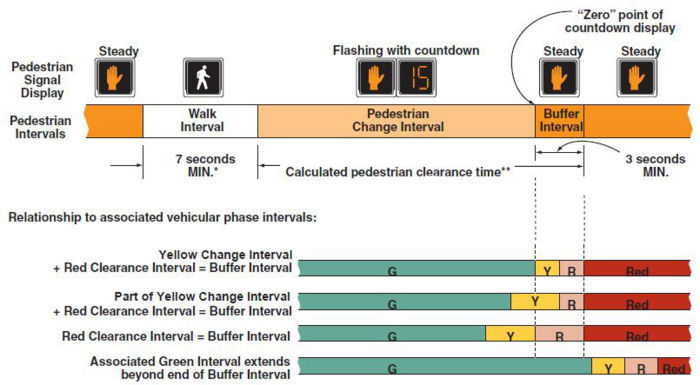
| LEGEND | G = Green Interval | |
| Y = Yellow Change Interval (of at least 3 seconds) | ||
| R = Red Clearance Interval | ||
| Red = Red because conflicting traffic has been released | ||
| * The Walk Interval may be reduced under some conditions (see EPG 902.6.6). | ||
| ** The Buffer Interval, which shall always be provided and displayed, may be used to help satisfy the calculated pedestrian clearance time, or may begin after the calculated pedestrian clearance time has ended (see EPG 902.6.6). | ||
Guidance. The pedestrian clearance time should be sufficient to allow a pedestrian crossing in the crosswalk who left the curb or shoulder at the end of the WALKING PERSON (symbolizing WALK) signal indication to travel at a walking speed of 3.5 ft. per second to at least the far side of the traveled way or to a median of sufficient width for pedestrians to wait.
Option. If pedestrian and/or other unusual characteristics exist and documented engineering judgment supports the use, a walking speed of 4 ft. per second may be considered.
Guidance. Where pedestrians who walk slower than 3.5 ft. per second, or pedestrians who use wheelchairs, routinely use the crosswalk, a walking speed of less than 3.5 ft. per second should be considered in determining the pedestrian clearance time.
Except as provided in the next Option, the walk interval should be at least 7 seconds in length so that pedestrians will have adequate opportunity to leave the curb or shoulder before the pedestrian clearance time begins.
Option. If pedestrian volumes and characteristics do not require a 7-second walk interval, walk intervals as short as 4 seconds may be used.
If pedestrian volumes and characteristics indicate that a longer walk interval is needed then the walk interval may be lengthened. Longer walk intervals are often used when the duration of the vehicular green phase associated with the pedestrian crossing is long enough to allow it.
Guidance. The total of the walk interval and pedestrian clearance time should be sufficient to allow a pedestrian crossing in the crosswalk who left the pedestrian detector (or, if no pedestrian detector is present, a location 6 ft. from the face of the curb or from the edge of the pavement) at the beginning of the WALKING PERSON (symbolizing WALK) signal indication to travel at a walking speed of 3 ft. per second to the far side of the traveled way being crossed or to the median if a two-stage pedestrian crossing sequence is used. Any additional time that is required to satisfy the conditions of this paragraph should be added to the walk interval.
If a pedestrian signal head is used that does not have a concurrent vehicular phase (exclusive pedestrian movement), the pedestrian change interval (flashing UPRAISED HAND) should be set to be approximately 4 seconds less than the required pedestrian clearance time and an additional clearance interval (during which a steady UPRAISED HAND is displayed) should be provided prior to the start of the conflicting vehicular phase. See Fig. 902.6.6.
Every effort is to be made to display the WALK indications with a green phase or interval. This "phase-associated" pedestrian operation lessens the overall delay to drivers. Using a fully actuated intersection as shown:
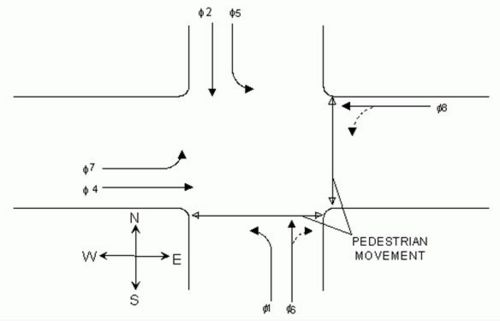
The pedestrian WALK and flashing DON'T WALK indications for northbound-southbound on the east side of the intersection would be displayed only during phase 6. Likewise, the indications for eastbound-westbound on the south side would be displayed only during phase 4.
Standard. Under no circumstance will a pedestrian WALK or flashing DON'T WALK indication be active during a phase or interval which leads vehicles into the crosswalk.
Guidance. Using the previous example, the pedestrian indications for northbound-southbound cannot be active during phase 5, or any phase for the east-west direction of travel. Pedestrian indications are allowed in conjunction with the phase 6 right turn (using the permissive indication) and/or the phase 5 southbound yielding left turn, if allowed, since the pedestrian movement has legal right-of-way over the northbound right turn or southbound yielding left turn.
Under rare circumstances, an exclusive movement might be needed for the pedestrian indications.
Other options should be considered prior to the installation of an exclusive pedestrian movement.
Option. On a street with a median of sufficient width for pedestrians to wait, a pedestrian clearance time that allows the pedestrian to cross only from the curb or shoulder to the median may be provided.
Standard. Where the pedestrian clearance time is sufficient only for crossing from the curb or shoulder to a median of sufficient width for pedestrians to wait, median-mounted pedestrian signals (with pedestrian detectors if actuated operation is used) shall be provided (see EPG 902.6.7 and EPG 902.6.8) and signing such as the R10-3d sign (see EPG 903.5.30) shall be provided to notify pedestrians to cross only to the median to await the next WALKING PERSON (symbolizing WALK) signal indication.
Guidance. Where median-mounted pedestrian signals and detectors are provided, the use of accessible pedestrian signals (see EPG 902.6.9) should be considered.
Option. During the transition into preemption, the walk interval and the pedestrian change interval may be shortened or omitted as described in EPG 902.5.38 Preemption and Priority Control of Traffic Control Signals.
At intersections with high pedestrian volumes and high conflicting turning vehicle volumes, a brief leading pedestrian interval, during which an advance WALKING PERSON (symbolizing WALK) indication is displayed for the crosswalk while red indications continue to be displayed to parallel through and/or turning traffic, may be used to reduce conflicts between pedestrians and turning vehicles.
Guidance. If a leading pedestrian interval is used, the use of accessible pedestrian signals (see EPG 902.6.9) should be considered.
Support. If a leading pedestrian interval is used without accessible features, pedestrians who are visually impaired can be expected to begin crossing at the onset of the vehicular movement when drivers are not expecting them to begin crossing.
Guidance. If a leading pedestrian interval is used, it should be at least 3 seconds in duration and should be timed to allow pedestrians to cross at least one lane of traffic or, in the case of a large corner radius, to travel far enough for pedestrians to establish their position ahead of the turning traffic before the turning traffic is released.
If a leading pedestrian interval is used, consideration should be given to prohibiting turns across the crosswalk during the leading pedestrian interval.
Support. At intersections with pedestrian volumes that are so high that drivers have difficulty finding an opportunity to turn across the crosswalk, the duration of the green interval for a parallel concurrent vehicular movement is sometimes intentionally set to extend beyond the pedestrian clearance time to provide turning drivers additional green time to make their turns while the pedestrian signal head is displaying a steady UPRAISED HAND (symbolizing DONT WALK) signal indication after pedestrians have had time to complete their crossings.
902.6.7 Countdown Pedestrian Signals (MUTCD Section 4E.07)
Standard. All pedestrian signal heads used at crosswalks shall include a pedestrian change interval countdown display in order to inform pedestrians of the number of seconds remaining in the pedestrian change interval.
Countdown pedestrian signals shall always be displayed simultaneously with the flashing UPRAISED HAND (symbolizing DONT WALK) signal indication displayed for that crosswalk. Countdown pedestrian signals shall consist of Portland orange numbers that are at least 9 in. tall on a black opaque background. The countdown pedestrian signal shall be located immediately adjacent to the associated UPRAISED HAND (symbolizing DONT WALK) pedestrian signal head indication (see Fig. 902.6.4).
The display of the number of remaining seconds shall begin only at the beginning of the pedestrian change interval (flashing UPRAISED HAND). After the countdown displays zero, the display shall remain dark until the beginning of the next countdown.
The countdown pedestrian signal shall display the number of seconds remaining until the termination of the pedestrian change interval (flashing UPRAISED HAND). Countdown displays shall not be used during the walk interval or during the red clearance interval of a concurrent vehicular phase.
Guidance. Because some technology includes the countdown pedestrian signal logic in a separate timing device that is independent of the timing in the traffic signal controller, care should be exercised by the engineer when timing changes are made to pedestrian change intervals. If the pedestrian change interval is interrupted or shortened as a part of a transition into a preemption sequence (see EPG 902.6.6), the countdown pedestrian signal display should be discontinued and go dark immediately upon activation of the preemption transition.
902.6.8 Pedestrian Detectors (MUTCD Section 4E.08)
Support. The provisions in this Section place pedestrian pushbuttons within easy reach of pedestrians who are intending to cross each crosswalk and make it obvious which pushbutton is associated with each crosswalk. These provisions also position pushbutton poles in optimal locations for installation of accessible pedestrian signals (see EPG 902.6.9). Information regarding accessible reach ranges can be found in EPG 642.
Guidance: If pedestrian pushbuttons are used, they should be capable of easy activation and conveniently located near each end of the crosswalks. Except as provided in the following two paragraphs, pedestrian pushbuttons should be located to meet all of the following criteria (see Fig. 902.6.8.1):
- A. Unobstructed and adjacent to a level all-weather surface to provide access from a wheelchair;
- B. Where there is an all-weather surface, a wheelchair accessible route from the pushbutton to the ramp;
- C. Between the edge of the crosswalk line (extended) farthest from the center of the intersection and the side of a curb ramp (if present), but not greater than 5 ft. from said crosswalk line;
- D. Between 1.5 and 6 ft. from the edge of the curb, shoulder, or pavement;
- E. With the face of the pushbutton parallel to the crosswalk to be used; and
- F. At a mounting height of approximately 3.5 ft., but no more than 4 ft., above the sidewalk.
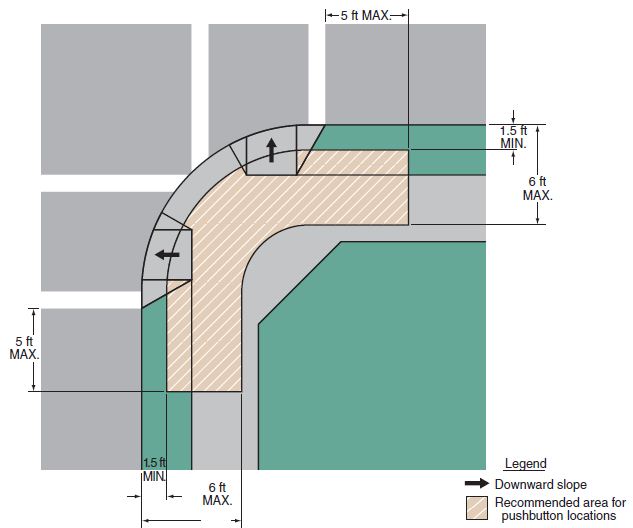
| Notes: |
| 1. Where there are constraints that make it impractical to place the pedestrian pushbutton between 1.5 ft. and 6 ft. from the edge of the curb, shoulder, or pavement, it should not be farther than 10 ft. from the edge of curb, shoulder, or pavement. |
| 2. Two pedestrian pushbuttons on a corner should be separated by 10 feet. |
| 3. This figure is not drawn to scale. |
| 4. Fig. 902.6.8.2 shows typical pushbutton locations. |
Where there are physical constraints that make it impractical to place the pedestrian pushbutton adjacent to a level all-weather surface, the surface should be as level as feasible.
Where there are physical constraints that make it impractical to place the pedestrian pushbutton between 1.5 ft. and 6 ft. from the edge of the curb, shoulder, or pavement, it should not be farther than 10 ft. from the edge of curb, shoulder, or pavement.
Except as provided in the Option below, where two pedestrian pushbuttons are provided on the same corner of a signalized location, the pushbuttons should be separated by a distance of at least 10 feet.
Option. Where there are physical constraints on a particular corner that make it impractical to provide the 10 ft. separation between the two pedestrian pushbuttons, the pushbuttons may be placed closer together or on the same pole.
Support. Fig. 902.6.8.2 shows typical pedestrian pushbutton locations for a variety of situations.
Standard. Signs (see EPG 903.5.30 Traffic Signal Signs (R10-3, R10-5 through R10-30)) shall be mounted adjacent to pedestrian pushbuttons, explaining their purpose and use.
Option. At certain locations, a supplemental sign in a more visible location may be used to call attention to the pedestrian pushbutton.
Standard. The positioning of pedestrian pushbuttons and the legends on the pedestrian pushbutton signs shall clearly indicate which crosswalk signal is actuated by each pedestrian pushbutton.
If the pedestrian clearance time is sufficient only to cross from the curb or shoulder to a median of sufficient width for pedestrians to wait and the signals are pedestrian actuated, an additional pedestrian detector shall be provided in the median.
Guidance. The use of additional pedestrian detectors on islands or medians where a pedestrian might become stranded should be considered.
If special purpose pushbuttons (to be operated only by authorized persons) are used they should include a housing capable of being locked to prevent access by the general public and do not need an instructional sign.
902.6.9 Accessible Pedestrian Signals and Detectors – General (MUTCD Sections 4E.09 - 4E.13)
Standard. Accessible pedestrian signals and detectors shall be considered upon request and evaluated based on the 2009 MUTCD and collaboration with Central Office Traffic.

